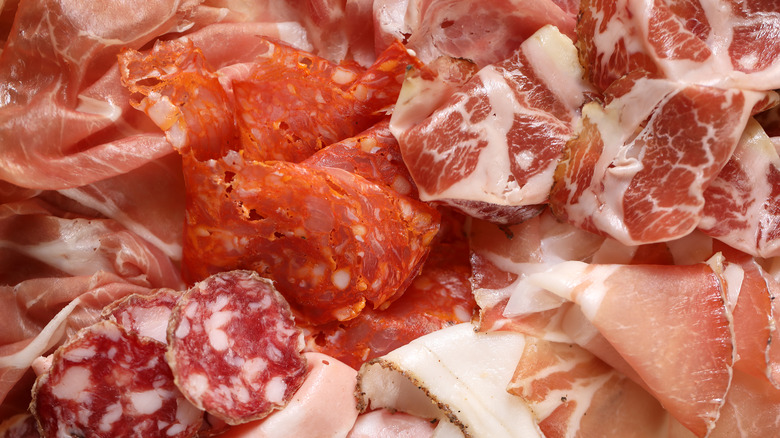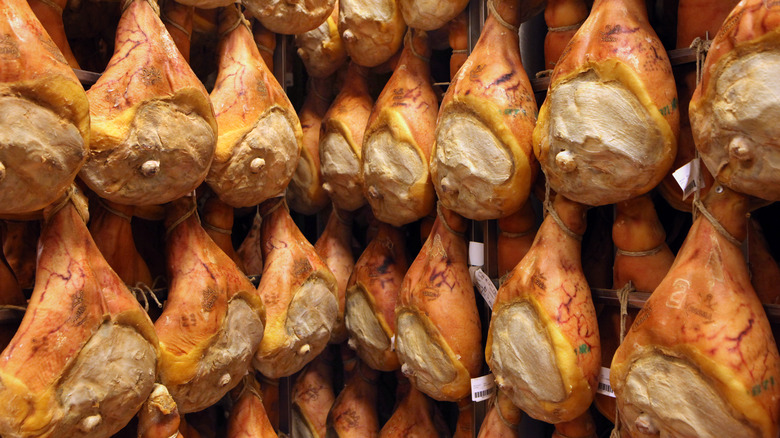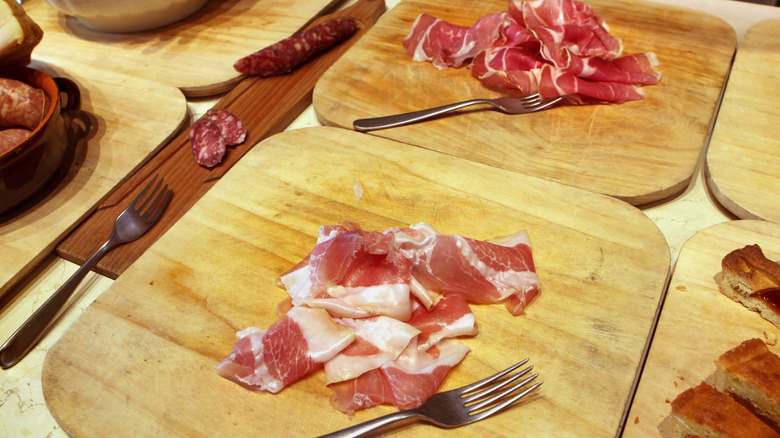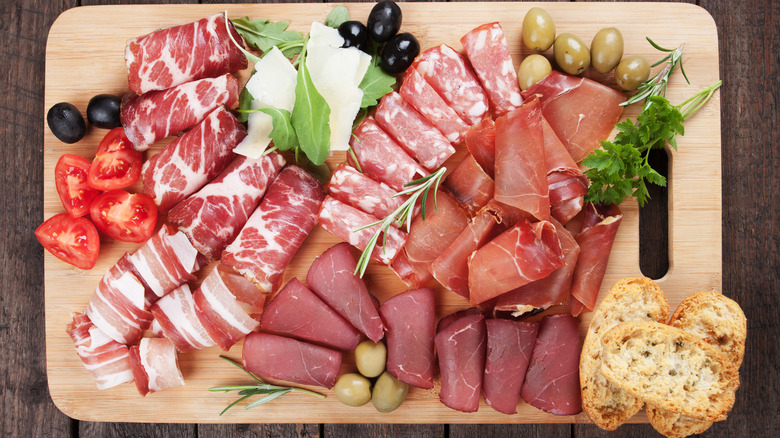The Differences Between Capicola And Prosciutto
When it comes to charcuterie, a selection of cured meats and cheeses along with some chutney and nuts can make a simple but perfect board. But no charcuterie would be complete without meats like capicola and prosciutto. These Italian cold cuts are known as salumi. The practice of curing meat dates back to Paleolithic times, when meats were sun-dried to preserve them. Salumi's first originated in 500 B.C. when the Romans and Etruscans began curing ham, which they ate at banquets or as street food with bread.
According to Italian Made, salumi is part of Italy's cultural heritage. Not even industrial production changed the traditions associated with making these cured cold cuts. Italian cured meats come in two categories: whole or minced and stuffed into casings. Both prosciutto and capicola are whole cut meats, according to 10 Best.
When going through your meat choices, sometimes capicola and prosciutto feel like they could be interchanged. While both are salumi, they are from two different parts of the pig and are cured in distinct ways, giving them unique flavor profiles and mouthfeel.
What is capicola?
According to Supermarket Italy, capicola takes its official name from the two parts of the pig that the cut spans: the head (capo) and shoulder (collo). Dry Age Pro claims capicola has graced the Italian table since the Middle Ages. The meat is recognized and protected by the European Union as a heritage food, says Delighted Cooking. Just as only true champagne comes from France's Champagne province, capicola can only be sold under the name if it originates from specific regions in Italy.
Capicola also goes by the unofficial name "gabagool" in the U.S., where Italian-American dialects changed the sound of the word, says Hardcore Italians. Since 80% of Italians in America hail from Southern Italy, the regional dialect for capicola (i.e. gabagool) became standardized in the United States. The term was popularized given its frequent use in the hit HBO series "The Sopranos."
Regardless of how it's pronounced, Daring Gormet explains the pork is covered herbs and spices and left to cure for several weeks. The salt is washed off and it's seasoned again, this time with paprika, red and black pepper, fennel, coriander, and other spices before being stuffed in a pork casing. After that, it's hung and dry-cured for six months.
What is prosciutto?
Prosciutto comes from the leg of the pig. According to Parma Crown, the ham can be cooked before curing (prosciutto cotto) or left uncooked (prosciutto crudo). Strict rules govern the making of the cured ham, and those rules are region-specific, like Di Parma, di San Daniele, etc. Each region's prosciutto has a distinct flavor due to the differences in pigs and the unique curing spices used in each area. For example, Prosciutto Di Parma and di San Daniele are cured simply with salt, while Prosciutto Toscano DOP uses spices like black pepper, rosemary, and juniper.
We have the early Romans to thank for prosciutto crudo (the uncooked kind, popular in the U.S.) when they discovered dry-aging would preserve the meat through the winter (via Farming Aquaponics). The leg is salted, which pulls the blood and moisture out of the meat to keep it safe from bacterial growth, and left for 90 days in a cold, humid area. Translated from Latin, prosciutto means to "suck out moisture" (via Cucina Toscana). Once cured, the salt is washed off and the leg is hung where air can circulate around it for at least a year.
The differences between capicola and prosciutto
The most apparent difference between the two meats is the cut, with capicola being a delicate meat between the neck and shoulder, per Olympia Provisions, while prosciutto is from the leg, says Eataly. FoodsGuy explains that this makes capicola a smaller cut than prosciutto, and thus its curing time is shorter. But because capicola has a lower fat content, it's missing that melt-in-your-mouth quality prosciutto lovers rave about. But, less fat means capicola is more tender.
While both are sliced thin, Farming Aquaponics points out capicola's smaller cut means it can be eaten in one bite. Prosciutto needs several to finish. The Rusty Spoon also details the differences in seasoning, with most types of prosciutto being simply salted, while a plethora of spices, salt, and paprika add to the flavor profile of capicola. There's also a difference in price; prosciutto's more expensive due to its lengthy curing process.
Enjoying capicola and prosciutto
Capicola is a versatile meat at home, on a charcuterie board, or in a classic Italian sub. How Stuff Works says capicola's saltiness pairs well with cheese, figs, olives, melon, and crackers, and that it is a key ingredient in some versions of New Orleans' famed muffuletta sandwich. Portlandians enjoy capicola-topped pizza. The Di Bruno Brothers plan your entire day's meals with capicola suggesting: "Scrambled eggs, ham capi, and American cheese sandwich for breakfast" for lunch, a "ham capi sandwich with provolone and mayo," and for dinner, "wrap[ing] it around asparagus or smaller cuts of meat before grilling."
Enjoying prosciutto is not all that different from its capicola cousin. Eataly recommends wrapping it around melon to take advantage of the interplay between sweet and salty. It can be added to a sandwich stuffed with cheeses and veggies or enjoyed simply on a piece of crusty bread drizzled with olive oil. You can even make an Italian version of a southern staple, the cheese straw. It's recommended that you eat it sliced straight off the leg since pre-packaging dries it out, and could become tough.




